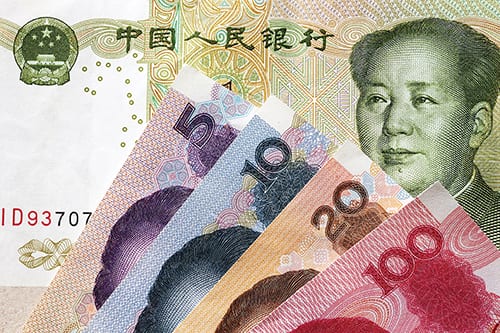by Jean-Claude Auger, Kyolaris Research Ltd., and Eduardo Nahmad-Achar, Instituto de Ciencias Nucleares, Universidad Nacional Autónoma de México
OCTOBER 2016 | Vol. 13, No. 10
Foreign multinational coatings companies leading the Chinese decorative paints business share two objectives: the regular release of ecofriendly products and the stimulation of the purchase of colored paints. In this article, we show that the realization of these goals is dependent upon certain assumptions whose validities may be questionable when seen in the Chinese environmental and cultural contexts. Instead, they may provide disruptive innovation opportunities for local firms.
OVERVIEW
For more than a decade, foreign multinational coatings companies (MNCC) have been rapidly expanding their dominance of the Chinese developing market. Currently, they are strongly established in most business activities, including decorative paints, powder, automotive, industrial, packaging, and marine coatings. First perceived as an opportunity to increase profitability, this dominance became a must-win market to secure the continuation and good performances of companies after the 2008 economic crisis and the weakening of the economic activities in Europe and North America that followed.
According to the Chinese official statistics bureau,1 in 2015, foreign MNCCs occupied the top five positions with annual sales revenues ranging from approximately EUR 1.84B to EUR 0.45B. These companies are Nippon, AkzoNobel, PPG, BASF, and Valspar. The first Chinese company only appears sixth in this ranking with sales revenues five times smaller.
The decorative paint business is also largely dominated by three foreign MNCCs—Nippon, AkzoNobel, and PPG. However, they face fierce competition from strong local players such as Beijing Red Lion, Hempel Hai Hong, and China Paint.
While each decorative paint MNCC follows its own agenda and expansion schemes, they also share certain common objectives because of evident strategic imperatives. Among these, two objectives are of particular importance in China: (a) the regular release of sustainable and ecofriendly products to the market, and (b) stimulating the purchase of colored paints.
In the following sections, we show that the realization of these two objectives is underpinned by a series of premises and analyses with validities that are questionable in the Chinese economic, environmental, and cultural contexts. In particular, we discuss the consequence of those inadequacies on the companies’ performances and the possible disruptive innovation they may create for local Chinese manufacturers.
ENVIRONMENTAL CONTEXT
The establishment of more stringent global regulations and the emergence of a worldwide social awareness of environmental issues have forced the MNCCs portfolios of research projects to include the following technological challenges: (a) to reach zero volatile organic compounds (VOC) content in the greatest possible number of coatings formulations. This implies, among other things, developing further water-based countertypes of solvent-based coatings, which are responsible for harmful VOC emissions into the atmosphere, without negatively affecting their performances; (b) to reduce the carbon footprint along the supply chain from the selection of raw materials to the production and distribution processes; and (c) to decrease the dependence on petrochemicals, for example, by developing biobased polymer technology.
The increasing number of environmentally friendly products released into the market and the implementation of “greener” processes are especially important in China, where both the environment and public health have been severely compromised for more than two decades by uncontrolled industrialization and rapidly growing urbanization.
Present business analyses perceive low-VOC water-based coatings, in which MNCCs have been investing millions of Euros for their development, as the long-term, ecofriendly technology solution of the decorative paints industry. This consideration is based on the comparison with the harmful effects on the environment of solvent-based coatings that they aim to replace. This view is, however, becoming debatable when considering that they contain about 50% of water by volume, and that water scarcity has emerged as one of the near-future most worrisome megatrends.2
By 2025, it is expected that two-thirds of the world’s population will live in water-stressed conditions. In the near future, mainland China, particularly the northern region, is likely to face water contamination and water supply crises.3,4 In 2015, Taiwan was confronted with one of the worst water scarcity situations in its history.
Water consumption impacts three end-user groups: individuals, agriculture, and industries. The former is already affected periodically to varying degrees by water restriction, the most current one being a lawn water ban. During the past year, domestic water alimentation was planned to be shut down two days a week in the northern cities of Taiwan. The reduction of water consumption is also an important topic of research in agriculture. As a result, some chemical companies have been proposing innovative products to increase water retention capabilities of soil to decrease the watering frequency of the fields.
Close examination of the industrial end-user group suggests that two situations can possibly affect coating manufacturers in the future: (a) governments may regulate the maximum fraction of water contained in certain categories of nonbasic necessities, or simply ban their use in regions strongly affected by water shortage; (b) independent of the existence of restrictive regulations, citizens could simply consider that non-essential products containing a significant proportion of water are detrimental to their well-being and subsistence. This sentiment may be strongly encouraged by environmental nongovernment organization (ENGO) campaigns. Therefore, customers may well turn to alternative products containing less water, if some were available on the market.
CULTURAL CONTEXT
For years, decorative paint manufacturers have been orienting their marketing and sales strategies to stimulate the purchase of colored paints because they are financially more profitable. In China, the growth opportunity and potential related source of new revenues are considerable as white paints alone presently represent approximately 85% of sales. To encourage changes in the Chinese customers’ purchasing behavior, MNCCs have implemented this strategy along two main axes that have been applied with relative success in western countries.
The first axis is mostly technology-based. It consists of being able to bring the largest number of colors to the market, assuming that in such conditions the customers are more likely to find the color that matches their expectations.
The second axis is purely marketing driven. It consists of using intense advertising campaigns to correlate the enhancement of the customers’ well-being when living in colorful surroundings rather than in dull, white, and gray environments.
Bringing a profusion of colors to the client was made possible after the development of reliable automatic tinting machines, which have since been deployed at most points of sale (POS). From a few white bases, a dozen colorants, and a reliable color matching software, the machines can deliver the selected color from among a panel of thousands in only a few minutes. As all MNCCs quickly mastered this technology, they are now proposing very similar color palettes to the consumer. Therefore, it is practically impossible for the average consumer to differentiate one brand from another on the sole criterion of color. To overcome this issue and to regain further differentiation from their competitors, paint manufacturers tend to promote additional characteristics of their commercial offerings such as brand recognition or services.
One major problem is that this marketing strategy appears to overlook the fact that color issues are related, among other things, to the psychological attribute of human visual perception, and thus are strongly connected to cultural references. Therefore, the content of the commercial message may appear to be largely inappropriate for Chinese customers.
Indeed, relating the choice of home interior colors to the owner’s well-being, mood, and personality, may be pertinent in the context of western culture and society. In China, however, a home, which can simultaneously accommodate up to three generations of the same family, is rarely perceived as a showplace to indulge in narcissistic feelings, but rather as a shelter that should be harmoniously designed to provide safety and good health, and to bring prosperity for all its inhabitants. Whenever possible, and still for a non-negligible part of the population, it should also provide protection from ghosts and bad luck. This cultural heritage is visible in the traditional building architecture, on the contour of the roofs, the design of the doorsteps, and even through the posters placed at the front door to welcome good fortune during Chinese festivities. It is also a component of Feng Shui, which is a Chinese ancestral philosophical system that teaches how to reach physical, moral, and intellectual fulfillment by acting on the careful management of the living environment.
In addition, using the improvement of the client’s well-being as the core-marketing message supposes that all other basic needs of the customer have been fulfilled. If such an assumption is certainly acceptable when considering the premium consumer segment, its extrapolation to the Chinese mass-market is rather far-fetched. It also excludes potential customers that would not have considered repainting their home based on simple decoration purposes, but who could have been receptive to a more appropriate incitation connected to their cultural reference such as the bringing of luck and prosperity to the family.
Finally, failure to properly consider the cultural aspect of color perception is strongly reinforced by the limitations imposed when implementing complexity reduction management initiatives on a company’s global scale. This involves, among other things, a worldwide standardization of names, products, and processes, mainly for cost-saving purposes. For example, the color names in color fan decks at the POS are not translated into Mandarin. Some MNCCs do, however, translate some of the names in short commercial brochures shown on the display unit. Nevertheless, names are chosen to reflect worldwide standardized significance. They often make reference to materials, vegetables, or fruits. For example, yellows are mostly referred to lemon, corn, or the sun.
Chinese marketing teams in charge of colors cannot provide any added values if their method has to be aligned to the global color marketing strategy, which is unconsciously inspired by the MNCCs native cultural background, and thus devoid of any regional character.
OPPORTUNITIES AND CONCLUSIONS
As mentioned, the two main objectives of decorative paint manufacturers are supported by a series of considerations that are ambiguous and problematic in China. These can be summarized as follows:
There is a strong antagonism between the increasing development of waterborne decorative paints, which are currently regarded as environmentally friendly products by paint manufacturers, customers, and law-makers, and increased water scarcity megatrend. In the future, those products could be reclassified as eco-unfriendly, especially in China where water shortage is already a significant problem.
Paint and pigment manufacturers have noticed for a long time that the gamut of preferred and most sold colors vary from one region of the world to another. They know how to adapt their supply chain accordingly so they can deliver the right colors without interruption and without a large quantity of unsold products. However, it still appears that the marketing strategy that is used to stimulate the purchase of colored paints does not consider the psychological attribute of color perception or especially cultural origins as an essential element. It appears to be either voluntarily sacrificed on the altar of the complexity reduction management initiative or simply neglected by ignorance. This could, however, be used as a proficient marketing angle to influence the Chinese customer’s purchasing behavior.
To anticipate and respond to the water scarcity issue, it is necessary to formulate decorative paints that contain less water by unit volume than the existing ones. The promotion of textured effects created by the use of specially designed trowels or paint rollers during the application process could facilitate the hiding of surface defects resulting from the higher viscosity and poorer leveling of the new paint.
The cultural aspect of color perception should be placed at the center of the marketing strategy. This would allow focusing on delivering the colors that really matter to the customers by producing appealing emotions triggered by their cultural reference.
Chinese mainland manufacturers located in the interior provinces of China, which are also well established in the economic and mass-market segments, have certainly the most suitable profile to succeed in such attempts for the following reasons:
- They are not concerned with the restriction imposed by the complexity reduction strategy applied on the worldwide scale. Therefore, selecting a key set of relevant colors and choosing their names can specifically and uniquely be based on Chinese history and cultural heritage such as Feng Shui.
- Mass-market customers living in central provinces of China do not have the same level of exposure to foreign cultures as those living in the first tier cities such as Shanghai, Beijing, and Guangzhou. Consequently, they are more likely to be more receptive to marketing campaigns based on national cultural reference.
- Local companies can work on disruptive innovation without worrying as much as MNCCs about the consequences and impact of market cannibalization.
References
1. Watson, Dan, “The Chinese Coatings Market,” Coatings World, https://www.coatingsworld.com/issues/2011-01/view_china-
report/the-chinese-coatings-market- (January 20, 2011).
2. Stierli, Markus and Stoop, Marina, “Water the paramount megatrend of our time,” Credit Suisse,
paramount-megatrend-of-our-time.html (April 4, 2012).
3. Dexter Roberts, “Think the Air Pollution Is Bad? China Faces a Water Contamination Crisis,” Bloomberg Business,
supply-is-contaminated-and-shrinking (November 2014).
4. “Water in China Desperate Measures,” The Economist, https://www.economist.com/news/leaders/21587789-desperate-measures (October 2013).


